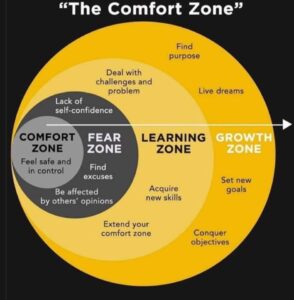Dealing with Discomfort
 Let’s talk about dealing with discomfort and this awesome graphic! So this might be my favorite graphic of all times. (I don’t know where it came from but I’d be happy to give credit). I look it up on a regular basis to remind myself. People who know me usually see me in one of two ways. The first way is as a brave person willing to changes careers, move across country, and tries new things. The other way is an overthinking person with anxiety, variable energy, and a recovering, perfectionist, overachiever. Both are true! The point here is that anxiety and fear are normal responses to doing things outside of your comfort zone. A lot of times, it’s telling you about your orientation to the trauma story from your past. In other words, anxiety and fear are usually not actually about the situation at hand. (Reckless behavior and serious risk taking notwithstanding).
Let’s talk about dealing with discomfort and this awesome graphic! So this might be my favorite graphic of all times. (I don’t know where it came from but I’d be happy to give credit). I look it up on a regular basis to remind myself. People who know me usually see me in one of two ways. The first way is as a brave person willing to changes careers, move across country, and tries new things. The other way is an overthinking person with anxiety, variable energy, and a recovering, perfectionist, overachiever. Both are true! The point here is that anxiety and fear are normal responses to doing things outside of your comfort zone. A lot of times, it’s telling you about your orientation to the trauma story from your past. In other words, anxiety and fear are usually not actually about the situation at hand. (Reckless behavior and serious risk taking notwithstanding).
The Benefits of Discomfort
Discomfort can cause us to lash out, shut down, blame, or avoid trying a new situation. Instead, if you can turn toward discomfort with interest, attention, compassion, and curiosity, then you are poised to make huge changes in your life.
Patterns of Avoidance
One of the common missteps I see people take on their therapeutic journey is to hide from discomfort or uncomfortable emotions. Ironically, however, such feelings bring with them incredible opportunities to know more about yourself and your needs. It is just in this moment of panic and “blech” that clients can get the most out of leaning in. What I mean by leaning in is showing up and exploring these dark, icky feelings with me in therapy. Sometimes the feelings might be about the therapist. This is a normal part of therapy too! In fact, it’s called transference, and is an integral part of the therapeutic process.
Consistency in Depth Work
Any huge undertaking is accomplished one step at a time. Likewise, therapeutic transformation requires sustained consistency. While every other week therapy may be enough to create a safety valve to release tension, depth work requires at least weekly consistency. You can’t expect to sculpt a toned physique through going to the gym twice a month. Psychological transformation requires the same pattern of effort. It is when you no longer need to talk about all the stuff that happened during the past week or so. Then, in a moment of not knowing what to say, something else arises. Something else forms on the art therapy page. It is then, beneath the overt activity of the week that new possibilities are able to arise from the unconscious.
It’s a long-haul game. It’s the difference between a 6-week bootcamp diet and the 3rd year of consistence attendance at the gym. You get the picture. We’re talking about self mastery and we’re also talking about creativity. If you’re willing to lean in with vulnerability and persistence, you will reap greater meaning and life satisfaction. It’s a beautiful process.
If you’ve been down a road long enough and are in the process of forging a new path, give me a call to see if this type of transformative, enriching process might be the support you’re seeking to aid you on your new journey. I know I’ve had it with repeating old patterns and get to where I said “enough is enough” let’s address it now. I’ve found that I’d rather deal with the discomfort now, instead of deal with a different discomfort of fear and avoidance over the long term.

Maggi Colwell
Maggi is a licensed art therapist at Columbus Art Therapy who assists their clients to discover more of themselves through dream analysis, art therapy, shadow work, and depth psychotherapy. They specialize in working with grief and loss as well as c-PTSD. Click the button to sign up for Maggi's newsletter to get notifications about new blogs and upcoming events including workshops, groups, rituals, and art.

